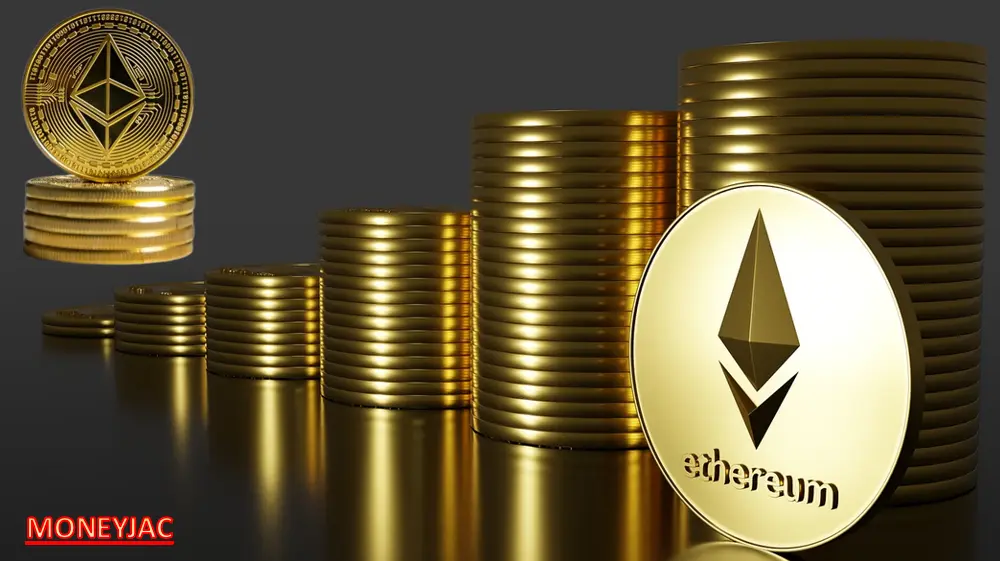Welcome to another great article from moneyjac.com! Today, we’ll explore the potential of Ethereum cryptocurrency. We’re excited to share this information, and if you find it helpful, feel free to pass it along to your friends. Let’s dive into the world of Ethereum (ETH) cryptocurrency together!
Ethereum Cryptocurrency is one of the most important cryptocurrencies today. It was created in 2015 by Vitalik Buterin and a group of developers, quickly becoming a leader in the digital finance world. What sets Ethereum apart is its ability to do more than just handle transactions. It introduced smart contracts, which allow developers to create decentralized applications (dApps) on the blockchain. Ethereum’s impact goes beyond just being a cryptocurrency. It changed how blockchain technology can be used, opening doors for a wide range of innovations in areas like finance, gaming, and supply chain management. Ethereum also plays a key role in the development of decentralized finance (DeFi) and non-fungible tokens (NFTs), both of which have gained massive popularity. Let’s explore Ethereum’s journey, its growth, and how it continues to shape the decentralized future.
You can read also – Bitcoin’s Journey: From Innovation to Global Impact and Its Bright Future
The Birth of Ethereum (ETH): A Vision Beyond Digital Currency
Ethereum Cryptocurrency was created to take blockchain technology beyond just digital currency. While Bitcoin focuses mainly on being a decentralized currency, Ethereum introduced “smart contracts.” These are self-executing contracts with the agreement terms written directly into code, allowing decentralized applications (DApps) to run on the Ethereum blockchain.
In 2013, Vitalik Buterin saw the limitations of Bitcoin and proposed Ethereum as a solution. By 2015, Ethereum’s blockchain went live, offering developers the chance to build decentralized applications on a secure, distributed platform. This opened up new possibilities in areas like finance, gaming, and more.
Ethereum’s ability to support various applications has led to the rise of decentralized finance (DeFi) and non-fungible tokens (NFTs), two of the most popular uses of blockchain today. These innovations have transformed how people use blockchain technology, offering decentralized alternatives to traditional financial systems and digital art.
Ethereum’s growth and flexibility continue to drive forward the development of blockchain technology, making it a key player in the evolution of decentralized systems.
Ethereum’s Growth: Powering DeFi and NFTs

Ethereum Cryptocurrency quickly became the foundation for most decentralized finance (DeFi) applications. DeFi aims to replace traditional financial services like lending, borrowing, and trading with blockchain technology. By using Ethereum Cryptocurrency, users could access financial services directly, without the need for banks or other intermediaries. This brought greater transparency and lower fees to the financial world. Platforms like Uniswap and Aave demonstrated how Ethereum’s smart contracts could handle complex financial operations, allowing users to interact with decentralized systems securely.
Another major innovation built on Ethereum Cryptocurrency is non-fungible tokens (NFTs). NFTs represent ownership of unique digital items, such as art, music, and even virtual real estate. Unlike cryptocurrencies, which are interchangeable, NFTs are one-of-a-kind. In 2021, the NFT market exploded, with digital artworks selling for millions of dollars. Ethereum played a key role in this boom with its ERC-721 standard, which was specifically designed for NFTs. This standard made it easier for creators to mint and sell NFTs on Ethereum’s blockchain.
Thanks to these developments, Ethereum Cryptocurrency showed that blockchain technology could do much more than support cryptocurrencies. It could transform entire industries, from finance to art. Ethereum’s ability to support DeFi and NFTs highlighted its potential to reshape the digital economy, opening up new opportunities for creators, investors, and users worldwide. Ethereum’s innovations continue to drive forward the adoption of blockchain technology across various sectors, making it a key player in the digital revolution.
The Challenges: Scalability and High Transaction Fees

Ethereum Cryptocurrency, despite its success, faced significant challenges as its popularity grew and network demand surged. One of the biggest concerns was the rise in gas fees, which are the transaction costs users pay to interact with the network. During times of high traffic, these fees became very expensive, making it difficult for many users to afford transactions. Another issue was Ethereum’s original proof-of-work (PoW) system, which was similar to Bitcoin’s. This method required miners to use a lot of energy to solve complex mathematical problems and validate transactions. As a result, it raised concerns about Ethereum’s environmental impact due to the high energy consumption involved in mining.
To address these problems, several solutions were introduced. One such solution was Layer-2 scaling technologies, like Optimism and Arbitrum. These platforms help Ethereum Cryptocurrency handle more transactions by processing them off the main blockchain and only settling the final results back onto the Ethereum network. This method reduces congestion and helps lower gas fees.
The most highly anticipated change was Ethereum’s move from proof-of-work to proof-of-stake (PoS). Proof-of-stake is a more energy-efficient consensus mechanism. Instead of miners solving complex problems, PoS relies on users who hold Ethereum Cryptocurrency to validate transactions, which greatly reduces the amount of energy needed. This shift, known as the Ethereum 2.0 upgrade, was completed in 2022. Ethereum 2.0 is expected to improve the network’s scalability, reduce transaction fees, and make the entire system more sustainable in the long run.
With these improvements, Ethereum Cryptocurrency is better equipped to handle increased demand while addressing key concerns about high fees and environmental impact. As the network continues to evolve, it is paving the way for a more scalable, efficient, and eco-friendly blockchain ecosystem.
Ethereum 2.0: Transition to Proof-of-Stake
The move to Ethereum 2.0 and its proof-of-stake (PoS) model was a game-changer. Known as “The Merge,” this upgrade reduced Ethereum’s energy consumption by over 99%, making the network much more environmentally friendly. In the PoS system, miners were replaced by validators who stake their ETH to help validate transactions and secure the network. This shift not only made Ethereum Cryptocurrency more sustainable but also increased its security and accessibility.
The Merge also paved the way for future scalability improvements, particularly through a technology called “sharding.” Sharding will split the Ethereum network into smaller, interconnected parts, allowing it to process transactions in parallel. This will make Ethereum faster, more efficient, and capable of handling a larger volume of transactions.
These upcoming upgrades promise to make Ethereum Cryptocurrency more attractive to both users and developers. With faster transactions, lower costs, and a more sustainable system, Ethereum 2.0 is positioned to be a key player in the future of decentralized technology.
Ethereum’s Growing Influence in a Multi-Chain World
Ethereum Cryptocurrency remains the most widely used blockchain for decentralized applications (dApps), even with the rise of newer networks like Solana and Polkadot, which offer their own unique features. Ethereum Cryptocurrency continues to lead in blockchain innovation, largely due to its strong community and established developer ecosystem. Many developers still choose Ethereum Cryptocurrency as their platform because of its security, flexibility, and large user base.
A key focus for Ethereum Cryptocurrency today is interoperability with other blockchains, especially with the growing trend of a “multi-chain” world. In this future, different blockchains need to communicate and share assets smoothly. Projects like Polygon and Cosmos help make this possible by enabling Ethereum to interact with other blockchains. This not only extends Ethereum’s reach but also enhances its functionality, allowing users to access a broader range of decentralized applications and services.
Ethereum Cryptocurrency is also playing an important role in the growth of decentralized autonomous organizations (DAOs). These organizations are run by their members, without a central authority, and are often used for governance in decentralized finance (DeFi) projects, NFTs, and other blockchain-based communities. DAOs allow members to vote directly on key decisions, embodying Ethereum’s vision of a decentralized, user-controlled ecosystem. This shift to decentralized governance aligns with Ethereum’s goal to create a world where users have more control and influence over their digital activities and assets.
Ethereum’s Future: Shaping a Decentralized World
Ethereum’s impact extends far beyond being just a digital asset; it has become a platform that embodies the principles of decentralization and user empowerment. As it evolves, Ethereum Cryptocurrency is set to drive advancements in blockchain technology, moving us closer to the vision of a fully decentralized web, known as “Web3.”
With upcoming scalability improvements, better privacy features, and a vibrant ecosystem of developers, Ethereum’s potential appears boundless. From decentralized finance (DeFi) to non-fungible tokens (NFTs), decentralized autonomous organizations (DAOs), and the future of a decentralized internet, Ethereum continues to lead blockchain innovation. Its influence is set to shape the digital landscape for years to come.
If you want to know more about Ethereum Cryptocurrency history, development and its future Potential then you can follow popular website like – Ethereum-Wikipedia
Common Queries Answered: Ethereum(ETH) FAQ
Welcome to the Ethereum (ETH) FAQ! Here, we answer the most frequently asked questions and give you clear, in-depth insights. Whether you’re just starting with cryptocurrency or are a seasoned investor looking to dive deeper into Ethereum’s possibilities, this guide is crafted to help you understand the essential aspects of this pioneering digital asset.
Qn1. How is Ethereum different from Bitcoin?
Ethereum and Bitcoin are both popular cryptocurrencies, but they serve different purposes and operate on distinct technologies.
- Purpose:
- Bitcoin was created as a digital currency to act as a store of value and a medium of exchange. Its main goal is to offer a decentralized alternative to traditional money.
- Ethereum, on the other hand, was designed as a platform for decentralized applications (dApps) and smart contracts. While it also functions as a digital currency (Ether), its primary aim is to enable decentralized computing.
- Blockchain Technology:
- Both Bitcoin and Ethereum use blockchain technology, but Ethereum’s blockchain is more flexible. It supports smart contracts, which are self-executing contracts with the terms directly written into code. Bitcoin’s blockchain is more focused on simple transactions.
- Supply and Scalability:
- Bitcoin has a fixed supply of 21 million coins, which makes it scarce and deflationary.
- Ethereum doesn’t have a fixed supply, which allows for more flexibility, but also means it can have inflationary characteristics. Additionally, Ethereum is evolving towards faster transaction speeds and lower costs through upgrades like Ethereum 2.0.
- Consensus Mechanism:
- Bitcoin uses Proof of Work (PoW), which requires miners to solve complex puzzles to validate transactions. This process is energy-intensive.
- Ethereum initially used PoW but is transitioning to Proof of Stake (PoS) with Ethereum 2.0. PoS is more energy-efficient as it relies on validators who hold and lock Ether to secure the network.
Qn2. What is Ethereum cryptocurrency 2.0?
Ethereum 2.0, also known as Eth2 or “Serenity,” is a major upgrade to the Ethereum network aimed at making it faster, more efficient, and more secure. The main goal of Ethereum 2.0 is to solve some key challenges of the original Ethereum Cryptocurrency network, like high energy consumption and slow transaction speeds.
The upgrade introduces a new consensus mechanism called Proof of Stake (PoS), which replaces the energy-intensive Proof of Work (PoW) method. In PoS, validators are chosen based on the amount of Ether (ETH) they “stake” or lock up, making the network more eco-friendly.
Qn3. How can I buy Ethereum (ETH)?
To buy Ethereum (ETH), you can follow these steps:
- Choose a Crypto Exchange: Sign up on a reputable cryptocurrency exchange, like Coinbase, Binance, or Kraken, which allows Ethereum Cryptocurrency purchases.
- Verify Your Account: Complete any required identity verification steps.
- Deposit Funds: Add funds to your account through a bank transfer, credit card, or other payment methods.
- Buy Ethereum: Find Ethereum (ETH) on the exchange, enter the amount you want to purchase, and confirm your transaction.
Your ETH will then appear in your exchange wallet, which you can transfer to a personal wallet for added security.
Qn4. What are Gas Fees?
Gas fees on Ethereum Cryptocurrency are the transaction costs required to execute operations on the Ethereum network, such as sending ETH or interacting with smart contracts. These fees compensate miners or validators for processing and confirming transactions. The cost of gas varies depending on network demand, with higher fees during busy times. Gas fees are paid in Ethereum’s native currency, Ether (ETH).
Qn5. What are DAOs?
DAOs (Decentralized Autonomous Organizations) are organizations that run on the Ethereum Cryptocurrency blockchain through smart contracts. They are governed by the community rather than a central authority. Members of a DAO can propose and vote on decisions, such as how funds are spent or what projects to pursue, all using Ethereum’s secure, transparent platform. DAOs offer a way for people to collaborate and make decisions collectively in a decentralized manner.
Qn6. What is a smart contract?
A smart contract is a self-executing contract where the terms and conditions are written in code and automatically enforced on the Ethereum blockchain. It allows for secure, transparent, and automated transactions without the need for intermediaries.
Qn7. Can Ethereum be mined?
Yes, Ethereum can be mined, but it’s transitioning away from traditional mining. Currently, Ethereum uses both Proof of Work (PoW) mining, where miners solve complex puzzles to validate transactions, and Proof of Stake (PoS), which doesn’t require mining. With the Ethereum 2.0 upgrade, Ethereum is moving fully to PoS, which will phase out mining entirely in favor of a more energy-efficient system.
Qn8. Is Ethereum safe?
Yes, Ethereum is generally considered safe due to its decentralized nature and strong security features. Transactions are secured by blockchain technology, making them transparent and resistant to tampering. However, like all digital assets, Ethereum can still face risks such as hacking, scams, or market volatility. Using secure wallets and trusted platforms can help enhance safety when dealing with Ethereum.
You can also read this: Shiba Inu Forecast:Price Analysis| What to Expect in 2023 2025 2030 2040 and 2050|Will it Break the $1 Barrier?
Conclusion
Ethereum (ETH) has come a long way since its inception in 2015, evolving from a basic platform for decentralized applications to a powerful ecosystem driving innovation across various industries. Its ability to enable smart contracts and decentralized finance (DeFi) has reshaped the way we think about money, ownership, and governance. While it faced challenges such as high transaction fees and scalability issues, Ethereum’s ongoing upgrades, including the shift to proof-of-stake and the upcoming implementation of sharding, promise to enhance its efficiency, security, and sustainability. As Ethereum continues to lead the way in blockchain technology, its future potential remains vast—shaping the next generation of the internet, financial systems, and digital ownership. With its expanding role in decentralized applications, NFTs, and DAOs, Ethereum is well on its way to becoming a key pillar of the decentralized world.
In conclusion, Ethereum’s journey has been one of constant growth and adaptation, and its future potential seems limitless. Whether through further network upgrades, enhanced decentralization, or new applications, Ethereum is set to continue making a profound impact on how we interact with the digital world.
